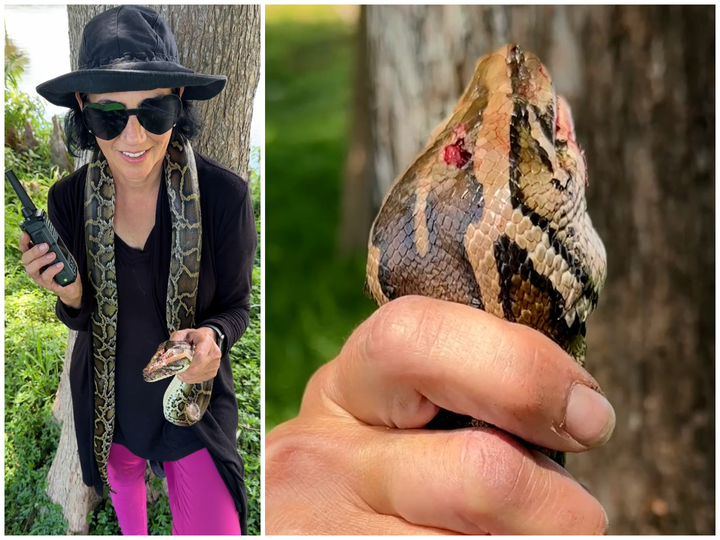Kym Clark was out for a casual early morning bike ride recently in a rural area near Everglades National Park, when she spotted something strange in the underbrush — the beautiful camouflage pattern of an invasive Burmese python.
To most, this might be a reason to pedal faster, but Clark slammed on the brakes. She couldn’t believe her luck. Clark, who hunts pythons as a hobby with friends and documents her adventures on her Instagram account, usually finds the invasive snakes at night along remote roadsides. To find one in broad daylight was a jackpot moment.
“I was just exercising, but I’m always looking for pythons if I’m in the Everglades,” she said.
Except this one looked odd. As she crept into the underbrush, alone, for a better look, she realized why. The snake, which was about 8 feet long, was coiled around an adolescent alligator, killing it.
Clark, who lives in Delray Beach, ran back to grab the snake stick she keeps strapped to her bike. When she returned, the snake saw her and uncoiled and started to slowly slither away. The alligator seemed dead, so Clark used the stick to gently rake the snake into the open, where she grabbed it behind the head.
Now what?
Clark is no stranger to handling pythons. She estimates she has caught and euthanized around 25 invasive pythons over the last 18 months. But all the gear needed to do the job properly and legally euthanize the snake — her air gun and pithing device — was five miles away, back at her car.
The state encourages people to hunt and remove the highly destructive invasive apex predators, but mandates a strict methodology for killing them. Hunters like Clark must render the snake unconscious — some hunters use air guns or captive bolts — then pith the brain by inserting a rod or screwdriver into the skull and moving it about.
Clark stood there with the snake still very much alive in her hands. How would she get it back to her car? This was supposed to be a peaceful morning ride, not a python “MacGyver” challenge. She’d have to get creative. There was no way she was letting this snake go. No way.
The predators, though here through no fault of their own, are just too good at what they do, and are decimating Florida’s wildlife. Native to Southeast Asia, they arrived in South Florida in the 1970s and ’80s via the exotic pet trade, and thrived when they escaped cages or were released into the wild.
They can survive for months without food and weeks without water. They’re born at 2 feet long, and grow to 6 feet within a year — too large for most wild predators in Florida. Researchers have found more than 75 species of mammals, birds, and reptiles in their digestive tracts, and in areas of Everglades National Park where the snakes dominate, mammal sightings have dropped by 98%. The longest ever caught in Florida was a mammoth 19 feet long.
Related Articles
Alarming elk attacks in Colorado tourist town: 2 kids and a dogwalker stomped
Biologists rescue young falcon who fell from San Jose City Hall nest
New bridge and trail to expand public access at scenic South Bay open space preserve
Mountain lion spotted near Happy Hollow Park and Zoo
How to survive a bear attack – or better yet, avoid one altogether
“I like to challenge people, if you go to Everglades National Park, try to find a mammal. I’ve been there endless hours, and I have not seen one live land mammal in several years, not one, nothing — raccoon, mouse, there’s nothing left. When people say, ‘How can you euthanize this snake?’ It’s because I see the devastation; we have no mammals left at our most beautiful national park. It used to be loaded.”
Over the decades, the snakes have expanded their invasion front, where they’re reproducing successfully, into the Keys and as far north as Lake Okeechobee and the suburbs of Fort Myers.
Birth of a python hunter
Clark’s obsession with pythons began about a year and a half ago when she came across a massive 15-foot-plus snake while driving through Everglades National Park. When she posted the video online, she caught a lot of flack for not killing it with her car.
“That thing was begging to be run over,” someone wrote. “You could have pinned it under your tire and waited for reinforcements!!!”
If she had, it would have been illegal — only licensed contractors can kills pythons in the National Park.
But seeing that big snake, wanting to help, and being criticized by the mob online, motivated her.
“That was the catalyst,” she said of her python journey. She apprenticed with an experienced hunter, and now rides rural roads at night with friends whenever possible, searching for the snakes.
The long rancid ride
It’s illegal to transport or possess live invasive species in Florida, but Clark actually has a permit that allows her to, so she hatched a plan. She taped the 8-foot snake’s mouth shut and held its head in one hand.
“I knew I had to get it back with me, so I thought, ‘How can I hold this thing and still safely ride a bicycle? How am I going to carry this without it constricting on me? So I figured if I wrap the python around my handlebars, at least it can’t wrap around me, and I could hold its tail and its head in my hands with the handlebars.”
It worked. Sort of.
“The snake kept sliding out of my hands and I’d have to stop and get a better grip. And it was musking me the whole time. They’ll spray you like a skunk,” said Clark. “It’s a very smelly liquid. We joke around that it’s not a good night unless we come home smelling like python musk. It smells like rotting animal.”
It was a long, bumpy, rancid ride, but eventually she made it.
Once she reached the car, she humanely euthanized the python, placed it in the back and headed home.
As for the alligator, as she was trying to figure out how to ride a bike with a python, she glanced over and saw it rise up on four legs and limp away into the brush.
“I never expected that in a million years. And I was so happy,” she said.
She gave the snake to a friend who wanted the skin.
He surprised her later by giving her the preserved skin back as a birthday gift. “He knew it was a special catch for me. It wasn’t the biggest snake, but it’s special because I got to release a native alligator. To me, that python symbolizes not just one gator release. Each python eats hundreds of animals, has hundreds of eggs. That python symbolizes hundreds of native animals that will be saved in the future.”












